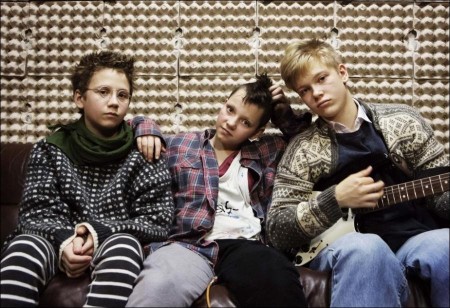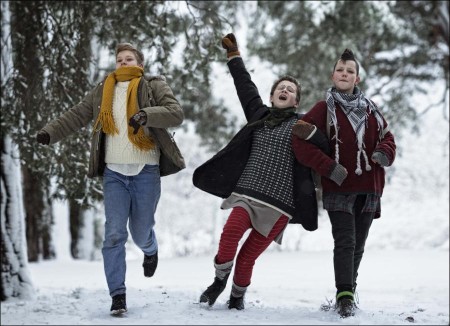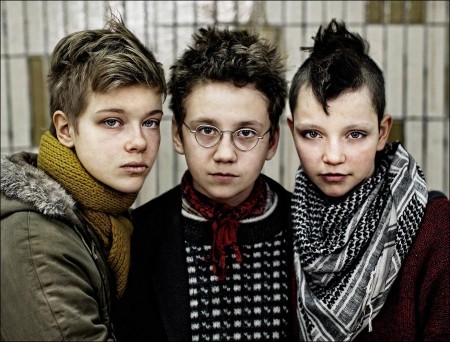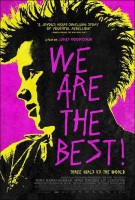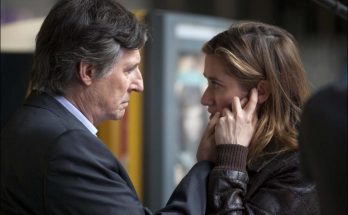Taglines: Taglines: Three girls vs. the world.
From Swedish auteur Lukas Moodysson, We are the Best! revolves around three girls in 1980’s Stockholm who decide to form a punk band — despite not having any instruments and being told by everyone that punk is dead. Based on a graphic novel, We are the Best! is a paean to DIY culture and the power of rebellion.
We Are the Best! (Swedish: Vi är bäst!) is a Swedish-Danish drama film written and directed by Lukas Moodysson and adapted from the graphic novel Never Goodnight by his wife Coco Moodysson. The film was screened in the Special Presentation section at the 2013 Toronto International Film Festival.
Following its premiere at the 2013 Toronto International Film Festival, We Are the Best! was released in its home country of Sweden on 11 October 2013. The film was later released in Denmark on 29 May 2014 and in the United States (via limited release) on 30 May 2014.
Director’s Statement
I wanted to make a film showing that life – despite all evidence to the contrary – is worth living. It’s wonderful to have a friend, wonderful to play an instrument without knowing how, wonderful to set fire to an old statue, wonderful to have the most annoying parents in the world, wonderful to throw up on someone’s records, wonderful to be booed and mocked, wonderful to be the best. – Lukas Moodysson
Q & A With Lukas Moodysson
Can you tell us briefly (not too briefly) what you’ve been doing during the four years since your last film appeared?
– After Mammoth I was tired both of film and myself as a director and sought out other avenues. I wrote two novels, taught at the Helsinki Film School, tried to become a good chess player – failed – and also tried to find a new ways of supporting myself financially, but didn’t come up with anything. I didn’t want to make any more films. Mammoth was a disappointment, to some extent the result but mainly the working process itself, which was long and tedious…
Well, that’s not entirely true: when my dad died during the post-production of Mammoth I thought of making a film about a dying father, a very, very small film: three actors, three people in the team, the opposite of Mammoth’s gigantic proportions. Then it dawned on me that I didn’t want to make the film, so instead I wrote a novel, Döden & Co. (Death & Co.). I’m most pleased with certain parts of it rather than the whole, which is always the case. Some of the lines, scenes and phrases are good. Then I wrote another novel, Tolv månader i skuggan (Twelve months in the Shadows), then I inherited a house in southern Sweden where I also got to see The Cure perform at a summer music festival, and that was one of the five or six happiest moments of my life
We Are the Best! is based on a graphic novel by your wife, Coco. Three teenage girls discover punk rock in 1982 and against everyone’s better judgement they form a band. What prompted you to adapt this story?
– I felt that in all the darkness that surrounds us I wanted to make a happy little movie that winked and glistened and told us that life isn’t entirely impossible. That there are ways and opportunities. A crucial point was to make a cheerful film, plus I wanted us to have some fun making it. Which isn’t necessarily the same thing.
The film slips and slides between your universe and Coco’s, and it’s hard to see where one starts and the other ends. It feels very much like a Lukas Moodysson film. But reading the book, most of the story and tone is already in place. What are your thoughts on that?
– Well, I wanted to replicate the tone of the book. I may have changed quite a bit of the story itself, but it was important not to mess with the tone. That’s usually my way: I’m not really so thorough with the storyline, I’m more interested in the tone, the mood, the details. I don’t really get the big picture. It may be a shortcoming on my behalf, as a human being and as a film director, but it’s also an ideological stance. I think it was Herta Müller who said, or she may have borrowed it from Ionescu: “we have to live in the details”. She also says that she doesn’t believe in utopias or blanket solutions.
Of course she states these things in a far more serious and grander context that I do, but the gist is the same: I also mistrust stories, explanations and ideologies which aim to explain everything. That’s why I’m so pleased with the open and very un-dramaturgical ending of We Are the Best! The film doesn’t say that the story about the three girls ends there. It carries on.
Can you say something about Hedvig, the one of the three girls who’s unique to the film?
– Hedvig is the born-again Christian who comes in and imposes some order on the two scatterbrains Klara and Bobo. It basically needed such an outsider in the group and I really doubt that the others would have formed a band without Hedvig.
The story takes place in 1982. What were you doing back then, and did your experiences help to shape the film?
– Just like Bobo, I thought Sex noll två (Six zero two) by KSMB was the world’s greatest song. I was enormously disappointed when I read that Johan Johansson, the writer of the song, said that he just wrote the lyrics as a joke and even as a parody of pretentious songs. I felt like calling him up and telling him that now you’re spitting right into my twelve-year-old face. And I honestly don’t believe him, it doesn’t matter what he says, I just know that the song is about yearning and loss and the like, it’s not a parody. Apart from that, I lived in a small town outside the city of Malmö in a terraced house, two terraced houses, my mum’s and my dad’s. I went around and don’t know how I felt, I wanted to go out with someone and get drunk and write poetry. Everything I’ve ever experienced helps me to shape every word I write. There’s a whole lot of me in this film.
You’ve given us stories about young girls before and you’ve also said that there’s an interesting challenge in doing so as a man. Can you elaborate on that?
– Well, this time it wasn’t my choice, I based it on Coco’s story, which in turn is based on Coco’s life… But it was fun to tell a story about three punk rockers who are girls. In hindsight, you have to admit that punk was pretty male-dominated, and although the punk scene was very important to me at the time, even back then I noticed a blokeishness which was pretty tedious. Personally, I wasn’t really that interested in biting into glass or putting out streetlights by smashing my head into the lamp-posts like some of the older punks I knew prided themselves in doing. Bakverk 80 – the compilation album that appears in the film, the album that Bobo lends to Elis, who, despite his tender age is already a pretty blokeish guy – is a perfect example. The album cover depicts a cake decorated with cigarette butts and beer caps. Only two women’s names appear in the credits, the two girls who baked the cake! The rest – musicians, songwriters, producers and what have you – are guys. So it was nice to get another perspective in this film.
Another thing that made the step so much bigger for any girl wanting to get into punk in 1977, in 1982 or in 2013, is that even alternative girls who listen to weird music are expected to be cute and pretty. It’s good when some of them go in the opposite direction, like Coco and her friends did in real life. Coco says – and I know where she’s coming from – that there were no cool girls to look up to, so she wanted to look like Fjodor, the bass player in Ebba Grön. I talked about all that with the two Miras and Liv when we worked on their clothes and hairstyles. I said that these people you are portraying don’t want to look nice, they want to look tough, and maybe fun, or to have a personal style, anything apart from compliant or pretty. That attitude was rare then and still is, perhaps even more so these days, at least when you’re in your early teens. And I’m very happy about this aspect of the film, that it’s about two people who later become three, who couldn’t care less about what’s expected of them. They choose their own path.
Let’s talk about the casting, a mix of fresh and established faces. How did you choose, especially, when it came to the three leads?
– I saw Mira Grosin in Astrid, a short film by Fijona Jonuzi. Liv LeMoyne sang and played guitar in a way that reduced me to tears. Mira Barkhammar came to the casting and said something or other during the first test, something seemingly insignificant, but it stuck with both Coco and me and we both thought: she really gets this. Regrettably, you don’t always go with your first instinct, so the process was lengthy and we tested a number of people. Many of them were really great. We also tested different combinations, it was hard work for the actors, and I always dread having to inform someone that they didn’t get the part, especially when they’re young and have been through five auditions. It honestly feels morally despicable.
When it comes to the grown-ups, I enjoyed casting some faces you’ve rarely seen on film. A nice touch is that Matte Wiberg and Johan Liljemark, the two youth recreation leaders, are actually members of the band Sabotage, who are part of the story. Brezjnev Reagan Fuck Off, the song we hear in the film, is their song. Johan had a one-week relationship with Coco when they were thirteen, something that greatly amused Mira and Mira, who did their best to make me jealous of the fact.
Through the years you’ve returned to certain regulars, among them cameraman Ulf Brantås, editor Michal Leszczylowski and your producer Lars Jönsson. Are these people especially important in the creative process?
– Everyone’s important. With Lars, I have a brilliant, slightly prickly working relationship. He makes me mad when he thinks I should do things differently, but unfortunately, he sometimes is right. My collaboration with cameraman Ulf is somewhat strange. We rarely speak, we just film, and we both believe in improvisation. We never or rarely plan; we just test things out without too much analysis. But with my editor Michal, there’s a great deal of analyzing, a very chatty relationship. Perhaps it’s the most crucial part of the whole working process. It feels as if you make the big, hard decisions in the editing room, that’s where you have to say what you really think about life, death, God and the rest. But many other people are important to me.
One is my director’s assistant, often Malin Fornander in the past, but this time around Fanni Metelius. She provided a sound foundation. I’m a bit of a scatterbrain and I need all kinds of help to structure my work. I also need someone to talk to, I don’t trust myself. I need to ask someone whose judgement I trust: was this good or was it rubbish? The crew was generally very good this time around, everyone contributed. And I felt afterwards that I’d got my zest for making films back, largely thanks to them. Making the film was fun, a pure joy to come to work every day. The evenings that followed were as awful as life itself can be at times, but the working days were just wonderful.
Coco is a prominent collaborator on We Are the Best! To what extent has she been an influence on your body of work over the years?
– Immensely. We are like twins, like Chip n’ Dale, two idiots together who think alike. She has always had a huge influence, but to call it an influence really isn’t right. It’s something far, far greater.
Which part or parts of the filmmaking process do you find the most rewarding?
– I was particularly fond of the wardrobe work on this one, finding the right look for these girls. I’m always interested in clothes and objects. I believe that exterior reality reflects inner reality, that objects have souls. It was enormous fun trying to find their outfits, trying to find their characters through their clothes. My grandfather Moody Carlsson had a jacket. I inherited it, my firstborn son later took it over, and it happened to be perfect on the Bobo character. Which made me overjoyed. I think that my grandpa, who was a farmer in Småland, would be amazed if he knew all the adventures his old worn-out jacket has been involved in. And then there’s the concentration, the hyper focus on the set, when your whole existence is concentrated in one spot. It feels like a drug.
Is there a common theme in your body of work? Or more than one, perhaps?
– Children and adults. Yearning for another place. Loneliness. Euphoria. I wish I could say something good happens when there’s tragedy all around, but I don’t know if that’s true. I wish it were.
Your films have been seen in many countries, both at festivals and in regular cinemas. Have you noted any difference in reactions in different countries? Or do you just let your films fly free after they leave the nest?
– Ideally they’re like messages in a bottle. I never get to know what happens to them. Just like Robert Smith never gets to know exactly what kind of emotions his music evoked in me at various points in my life.
If someone suggested that We Are the Best! is a return to films like Show Me Love and Together, how would you react?
– Well, that’s fair enough. There was a tone in those films that I longed to return to. Now I’m talking about tones again, like when Bob Dylan talked of a silvery tone inside his head that he managed to get out there just once on record and I totally get this. I can wake up in the middle of the night in tears over a tone or a timbre and then I’m devastated over the fact that I won’t be able to convey it in writing or on film. Now and again in this film I think I find them – I have lots of different tones – in a line, a glance between two characters, even an entire scene. Like when Bobo cuts Hedvig’s hair and looks at her and says “Look at it this way: it’ll grow back”. A moment like that is worth the entire film. Or when Bobo’s mum turns up with dinner and Bobo’s dad exclaims “Yeay, chicken” and some of his looks in that scene, they’re so perfect. It’s as if everything has fallen exactly into place. Those moments are everything that I aim for in concentrated form. Moments like that can reduce me to tears.
Your first feature Show Me Love in 1998 was widely regarded as a new and fresh film on the Swedish cinema scene. That was fifteen years ago. How established do you feel today, or how rebellious? Have you kept your youthful inner flame?
– I rarely think of myself in relation to the rest of the film world. I socialise with very few people in the industry, actually I don’t socialise with many people at all…
I’m not very interested in any position I might hold in Swedish cinema. I do what I do. “They can say whatever, I’ma do whatever”, as Rihanna sings. She’s my idol at the moment, she saved my life this summer, which once again proves that we need art or we perish. Anyway, you can say whatever, I’ma do whatever I want to do. As long as I’ve got some good shoes – the more expensive, the better.
Seriously, it’s quite awful to be publicly evaluated, given stars and grades and the like, and that’s the reason why every single day I think of some other line of work that I could possibly get into that isn’t public. The problem is, my dream job – fireman or paramedic – isn’t really going to happen. But I digress. Keeping a youthful inner flame… I don’t know. I feel young and I feel old, I believe in continuity and change, in the revolt of youth as well as the wisdom of age. If you try to keep young by repressing the march of time you just deceive yourself.
What does the future hold for you, creatively speaking?
– A romantic comedy, I hope. But there’ll be death and misery too. I just need to write it first. And before that I need to get some good pens and ink and paper. Everything affects everything else, I write very differently with different pens compared to on the computer. Right now, I’m in the middle of two different fountain pens: Sailor PG and Pelikan 800, and three or four different inks, among them the Japanese Pilot Iroshizuku Asa-Gao och Iroshizuku Fuyu-Syogun, said to have a colour of an old man’s winter, although I myself tend to recall a combination of a thundercloud and my old Einstürzende Neubauten t-shirt, which was black in high school but now is grey. Coco uses it these days.
It’s combinations and details like these that interest me whether I’m writing a cryptic little poem or something full of energy and joie de vivre. Small nuances are what please and interest me, though you wouldn’t know that if you saw me direct. I probably look a bit unbalanced and chaotic. I feel like a gardener planting plants that I let loose to grow wild. I love surprises, when things don’t turn out the way I expect, I love shooting scenes where I get to spend time on the floor doubled up with laughter, wondering what the actors are up to.
Note: KSMB and Ebba Grön were both highly prolific representatives of the very lively Swedish punk scene of the late 70s and early 80s. Bakverk 80 was a compilation album released in late 1979 featuring KSMB, Travolta Kids and Incest Brothers. Sabotage was one of the countless smaller bands of the era.
Q & A With Mira Barkhammar, Mira Grosin and Liv LeMoyne
In a way, the three of you have all been transported back in time. How does 1982 seem to you?
Mira Grosin: People spoke differently. We couldn’t say some of the things we say now, we had to finish sentences more.
Liv LeMoyne: It feels like there was more to fight for, still a bit of the spark of the hippie movement of the 60s and 70s.
Mira Barkhammar: Absolutely. Our characters are politically aware and anti-establishment.
LeMoyne: The clothes were more comfortable, before the “Greed is Good” of the 80s kicked in. It was still punky and rebellious back then. People seem more laid back nowadays.
Grosin: We’re very political, partly through being into punk but also in general. To have been a punk in 82 seems very cool. It may not have been the latest thing but at least there were people who did it. You never see any punks these days.
Barkhammar: The school world and the way kids behaved felt different. What was in and what was out seemed a bigger thing, and people could be mean to each other in a pretty straightforward way.
LeMoyne: Right. Personally, I’ve never experienced that in real life. There are other ways to be mean these days, more subtle ones. Like you’ll get maybe three likes on Facebook instead of twenty. Back then someone might come right up to you and say: “You are so bloody stupid” Basically, people are more cowardly these days.
Barkhammar: I gradually got used to the world of the film. And after a while, it all felt quite normal.
LeMoyne: I’d have liked to live then. It seems more fun. More spontaneous. Better music. Real records, real books, no iPads. A book is special, you can leaf through it, it’s physical.
Barkhammar: I’d have had a hard time not being able to call people up when I needed to. That’s a panic scenario.
Grosin: I wouldn’t have liked it, I’m totally dependent on my mobile. I don’t even know whether computers and stuff even existed back then. Really weird.
LeMoyne: I would certainly have missed being connected to the rest of the world. Nowadays it’s easy to live in Stockholm and know what’s happening in America or Spain. In 1982 you’re in Stockholm and that’s that. If you want to know what’s happening you have to mess around and get newspapers and stuff. But still, it was calmer, there was less stress. And better music. Today’s music is dead boring.
What did you know about Lukas, and how have you found working with him?
Barkhammar: I came across his name when they put out the ad. My mum told me about things he’d done and I realised I’d seen Fucking Åmål. I’m very into films, especially Swedish films.
Grosin: I didn’t know who he was. But six months before the ad, I’d actually won a second hand DVD of Fucking Åmål in a raffle. I really liked it.
LeMoyne: Today I’ve seen Fucking Åmål, Together, Mammoth and even Lilya 4-ever, although I wasn’t really supposed to. My mum tried to explain, but I got the measure of him when I first met him. He felt like a Moomin character, like Snufkin – calm and wise.
Barkhammar: The first thing I noticed was that he didn’t really look at me. And he never gives you a hug.
LeMoyne: I wonder if he’s always that cautious around others? But he’s brilliant at analyzing people. Brilliant at finding three girls who go really well together like we do.
Barkhammar: He lets us improvise a lot, but you understand what he’s aiming at. I get it immediately. He sits there silent and withdrawn, knowing exactly what’s happening and who you are, even when you do fifteen takes of the same scene.
Grosin: He’s great fun to work with. On my first film, a short called Astrid I had to follow a script quite closely. With Lukas pretty much anything goes and you still nail it. And if he sees us doing something good, he puts it into the film. When I watch it, I see myself just as much as Klara in the character. He really feels alive when he’s filming.
Will you carry on in films, do you think?
Grosin: When it was all over I was worn out. Never again! But now I’d like to make another film. Then again, I’ve done it so I don’t have to do it again. But if I do, I don’t want any crap jobs. I want to study the script first.
Barkhammar: I’m up for it. But now I’ve been spoiled. Everything was so awesome. I wouldn’t take just anything.
LeMoyne: I feel as if I’ve set a standard for myself. Uplifting films, like Fucking Åmål. You just feel “Yeah! I can do things too!” I really hope our film is like that.
We Are the Best
Directed by: Lukas Moodysson
Starring: Mira Barkhammar, Mira Grosin, Liv LeMoyne, Johan Liljemark, Mattias Wiberg, Jonathan Salomonsson, Anna Rydgren, Lena Carlsson, Ann-Sofie Rase, Lily Moodysson
Screenplay by: Lukas Moodysson
Production Design by: Paola Hölmer, Linda Janson
Cinematography by: Ulf Brantås
Film Editing by: Michal Leszczylowski
Costume Design by: Moa Li Lemhagen Schalin
MPAA RatingB None.
Studio: Magnolia Pictures
Release Date: May 30, 2014
Visits: 96
